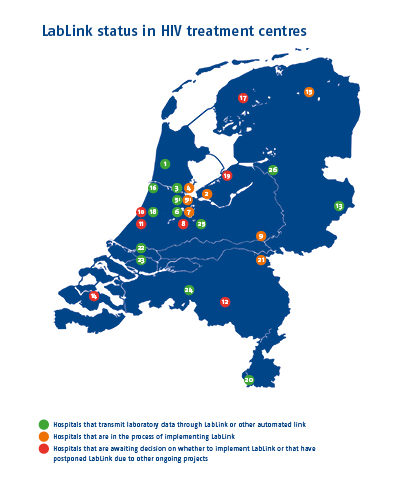LabLink goes live at OLVG: a case study

More efficient data collection and a significant improvement in data quality
According to Sima Zaheri, manager of SHM’s Data & Quality Control unit, collecting data from all the HIV-positive individuals in care in the Netherlands is a labour-intensive process. “This is why, just after SHM was set up, we already started looking at how we could make the process more efficient. We started in 2003 with a move to improve efficiency in the collection of laboratory results. These data don’t require interpretation and need to be entered exactly as they stand in the record. This process is clearly sensitive to errors and time-consuming. Back in 2003, we therefore agreed with a number of hospitals that they would send their laboratory results to SHM in a certain automated format so that these results could be imported into SHM’s database. Following this move, we carried out an evaluation in 2005 that showed that the automated transmission of laboratory results not only improved efficiency, but also resulted in a significant improvment in data quality,” explains Sima Zaheri.
The run-up to LabLink in OLVG
In 2013, this efficiency move was extended by standardising the format in which hospitals transmit laboratory results. Now laboratory results can be sent as so-called HL7 messages, an international standard by which the results are transmitted automatically from the laboratory to SHM through a digital virtual private network (VPN) connection (click here for an example of an HL7 message). While this connection is ultimately set up by the IT department of each hospital, it is preceded by a fairly extensive preparatory phase that involves various other hospital departments, such as the laboratory, the data management department, the HIV treatment team and the legal department. Sima Zaheri: “We realise that this can be a complex request, particularly in large hospitals, and we were therefore very pleased that OLVG had someone who was appointed to drive the process.” Prof. Kees Brinkman, chief HIV-treating physician at OLVG, elaborates: “In our hospital, Rosa Regez (Head of Internal Medicine Research at OLVG) was responsible for all the consultations required to make things happen. When the process seemed to be getting stuck, it was my job as chief physician to give things a nudge in the right direction.”
Once all the parties involved had given the go-ahead and the preparatory work had been completed, it was time to build the connection between OLVG and SHM. This step was carried out by the system engineer for OLVG's clinical chemistry & haematology laboratory, Jeroen van Leeuwen. “Building the actual connection is not that complicated,” says Jeroen van Leeuwen. “However, we did have to think carefully about how to send the data in an anonymised form. While the patient’s information is known in the hospital, it can’t be sent to SHM. In the end we decided to delete the patient information from the relevant fields before sending the laboratory results as an HL7 message. Achieving this was really the biggest challenge.”
Using data to improve health care
The laboratory results that SHM receives through LabLink are not only vital for monitoring the HIV epidemic in the Netherlands, but also important for the HIV treatment teams, which receive centre-specific and patient-specific reports from SHM. These reports can help to improve patient care, as well as being necessary for hospitals to obtain certification as an HIV treatment centre. LabLink renders manual collection of laboratory results more or less unnecessary. As a result, not only are data available sooner, they are also more reliable. This is beneficial for the treatment centres, including OLVG. “Because the data are transmitted directly to SHM, they are available in the system in real-time and are far more accurate. At OLVG we are currently undertaking a quality improvement process where we monitor the patient not only by looking at numbers, but also by looking at how the patient is doing in more general terms. We use SHM’s data to give ourselves feedback on how we are doing. The process is evaluated every six months or so, but this isn’t possible if there is a delay in data entry. So, the fact that the data are now being transmitted automatically will be very helpful,” says Prof. Brinkman.
In addition, this efficiency move gives the data collectors more time to reduce the back-log in data collection, which means that other data besides laboratory data are also entered into the database sooner. Furthermore, data collectors have more capacity to collect other data that are required for a specific research proposal, for example. Brid Peeck, one of SHM’s data collectors at OLVG, has already noticed an improvement in the efficiency of data collection: “In the past, I would sometimes spend a few weeks just entering all the laboratory results of a single patient, particularly if they had been in hospital for a prolonged period of time. A hospital stay involves laboratory tests at least once a day, and sometimes twice a day, all of which have to be entered into the database. This kind of situation doesn’t arise anymore now that laboratory results are sent automatically through LabLink.”
More laboratory results to be collected through the OLVG
Although OLVG itself now has a LabLink connection, the process has not yet ended. A number of other hospitals in the area (including MC Slotervaart, Hiv Focus Centrum, Medisch Centrum Jan van Goyen, OLVG West and Flevoziekenhuis) make use of the OLVG laboratory services and will therefore, in time, also send their data through OLVG’s LabLink connection. MC Slotervaart is the first of the hospitals to have started sending laboratory results through LabLink, and SHM is now in the process of making agreements with OLVG and the other HIV treatment centres about transmitting laboratory results though LabLink. “For example, it is important to be clear about who is responsible for registering patients for LabLink. For privacy reasons, this can’t be done by SHM,” explains Rosa Regez. “These issues have to be discussed separately with each hospital. This is partly why we chose to first set up LabLink in OLVG and make sure it was working properly before other hospitals start making use of it,” adds Sima Zaheri. “Our goal is to have these hospitals sending laboratory results through LabLink by the end of the year.”
“From a technical point of view, adding another hospital isn’t a problem,” says Jeroen van Leeuwen. “We had already taken this into account when we built the connection, as well as the possibility of expanding the data collected through LabLink to other research topics, such as hepatitis mono-infection. This makes it very easy to further expand the automated transmission of data, both now and in the future.”
Checks still necessary
Having a connection that automatically transmits the data to the database does not mean that the data collection process ends there. SHM data manager, Anne de Jong drives the LabLink process, including the data quality checks at the end. “The problem is that the hospitals don’t all use the same terms for a particular measurement. So we have to couple the measurement to the term used in our database by means of a mapping tool. Moreover, sometimes it’s not possible to map a measurement properly and in these situations the data collectors still play an important role. They look at the patient records to see which laboratory results or data are missing and, if possible, add them to the database by looking them up in the records and entering them manually,” says Anne de Jong. He continues: “It is also important to check that we are receiving information from the right patients, and of course our data collectors carry out specific quality checks on the data obtained through LabLink.”

Click here to see the map with corresponding list of treatment centres
The next steps
In addition to the hospitals that are still to be connected to LabLink through OLVG, there are a number of other hospitals that are not yet connected either. Many of these hospitals have other ongoing IT projects, such as the implementation of electronic record systems (e.g., VUmc, Medisch Centrum Leeuwarden and Catharina Ziekenhuis). These projects naturally take priority, but can result in the implementation of LabLink being delayed. Other reasons for the postponement of LabLink include switching to a different laboratory system or inadequate technology within the treatment centre. “In these cases, we maintain close contact with the hospital and stay up to date with the developments,” explains Anne de Jong. “At the moment, we hope that, together with the chief physicians and others involved in the process, we can ensure that LabLink is live in all hospitals within the next two years,” adds Sima Zaheri.
In the meantime, SHM continues to regularly investigate ways in which the data collection process can be further standardised, thereby saving time that can be used to reduce the back-log in data collection and to manually collect more, and other, data. “We’ve also taken this into account in the construction of our new data entry system, which will go live in 2018. The decision-tree structures that are being integrated into this new system will make it easier to automate the collection of other types of data. We expect that the collection of medication data will be the next process that can be automated,” concludes Sima Zaheri.
